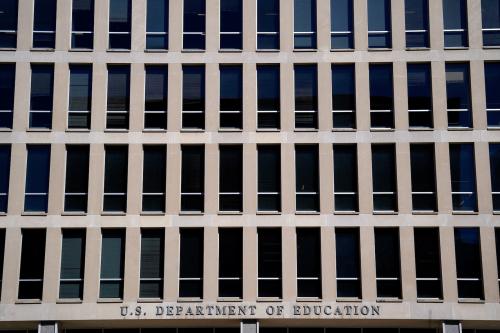OVERVIEW
After war and the economy, one of the most important issues of concern to the American public is education. The purpose of this paper is to summarize and assess the education proposals of both presidential candidates. The paper addresses the candidates’ proposals in four areas: preschool programs, elementary and secondary education, after-school programs, and higher education.
Preschool programs. Senator Kerry has said that he wants to make preschool universal. However, in the interest of keeping deficits under control, he has backed away from a specific proposal in this area. And although he has promised to “work toward” full funding for Head Start, a preschool program for disadvantaged children, he has not spelled out a specific initiative in this area either. President Bush has left Head Start funding essentially unchanged, although he has proposed a controversial experiment with block granting the program to enable states to better coordinate existing early education programs. Most independent research about the benefits of Head Start is somewhat inconclusive, although model preschool programs targeted to disadvantaged children have had impressive educational and social benefits.
Elementary and Secondary Education. The passage of the “No Child Left Behind” (NCLB) law in 2001 was one of the most high-profile pieces of domestic legislation in President Bush’s first term. The goals of the law are accountability and reducing achievement gaps between more and less advantaged students. Federal spending on elementary and secondary education increased from $18.5 billion in 2001 to $22.5 billion requested in 2005. Future increases are likely to be constrained by the need to reduce record deficits. Both Kerry and Bush support restraining the growth of domestic discretionary spending (outside of homeland security) to the rate of inflation (Kerry) or somewhat less than this (Bush). However, Kerry advocates exempting education spending from this cap on discretionary spending by proposing a ten-year $200 billion entitlement to the states for education spending. (Our understanding is that the total would include not only spending to achieve the goals of the NCLB law, but also other education initiatives such as spending on special education and a tax credit for college attendance. Roughly half the total, or $100 billion, would be devoted to NCLB.) Both candidates support improving teacher qualifications and demanding accountability. The debate between them would seem to hinge on the extent to which improvements in student performance can be achieved without significant additional resources and whether these resources should be provided by states or by the federal government.
After-school programs. Kerry has proposed to expand and revamp the 21st Century Community Learning Center Program, an academically-oriented after-school program targeted to poor school districts (authorized as part of NCLB). Funding would be expanded from $1 billion to $2.5 billion by 2007. The revamped program would shift the focus from exclusively academic benefits to include emphasis on values and decision-making skills that encourage children to avoid drugs, crime, and other risky behavior. The program would be required to stay open until at least 6 p.m. and provide school bus transportation. Bush had proposed cutting the funding for after-school programs in fiscal year 2004, but was rebuffed by the Congress last year, and he has not requested cuts in this year’s budget. A preliminary evaluation of the 21st Century program by Mathematica showed negligible effects on academic improvement in the program’s first year, but it remains extremely popular with parents and with members of Congress.
Higher Education. Kerry proposes to reduce the cost of attending college by expanding tuition tax credits for most households. The maximum value of existing credits would increase from $1,500 to $2,500; they would be available for four years instead of two; and they would be made refundable so that families without tax liability could also benefit. Bush has supported modest spending increases for the Pell grant program, which provides assistance to lower-income families. The maximum value of the Pell grant was $3,750 in the 2001-2002 school year and $4,050 in the 2003-2004 school year, an increase of about 1 percent after inflation, with further increases proposed for students who take challenging courses in high school or agree to study math or science in college. While there is no question that higher education aid in any form reduces the financial burden on students and their families, it is not clear how much effect such aid has on college attendance rates. Especially for the middle-class, it may operate primarily as another form of tax relief.
Many of the proposals discussed in this discussion draft are in flux or have not been fully specified. Where necessary, we have made our own assumptions about them explicit and await further clarification from either campaign where we have been in error.
The Brookings Institution is committed to quality, independence, and impact.
We are supported by a diverse array of funders. In line with our values and policies, each Brookings publication represents the sole views of its author(s).



